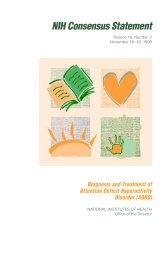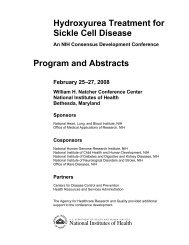Patient education, close supervision by an interested physician, and regular dietary counseling bya dietitian are the most important factors in achieving dietary compliance. (32) Compliance isimproved, even in adolescents, who are seen by a physician on regular basis. (33,34) Dietarycompliance assessed by a trained interviewer is the best marker of CD control due to low cost,noninvasivity, and a strong correlation to intestinal damage. It will also reinforce the need forstrict adherence to a GFD and educate the subjects in the avoidance of gluten-containing foods.Future research must be directed at finding alternatives to the GFD, which will in turnincrease compliance with treatment. These future potential treatments may include thedevelopment of genetically detoxified grains, an oral or intranasal “celiac vaccine” to inducetolerance, inhibitors of the effects of zonulin on intestinal permeability, (35) or detoxification ofimmunogenic gliadin peptides via oral peptidase supplement therapy. (36)References1. Meeuwisse GW. Diagnostic criteria in coeliac disease. Acta Paediatr Scand. 1970;59:461–463.2. European Society of Paediatric Gastroenterology and Nutrition. Revised criteria for diagnosisof coeliac disease. Report of Working Group of European Society of PaediatricGastroenterology and Nutrition. Arch Dis Child. 1990;65:909–911.3. Ciacci C, Cirillo M, Cavallaro R, Mazzacca G. Long-term follow-up of celiac adults ongluten-free diet: prevalence and correlates of intestinal damage. Digestion. 2002;66:178–185.4. Lee SK, Lo W, Memeo L, Rotterdam H, Green PH. Duodenal histology in patients withceliac disease after treatment with a gluten-free diet. Gastrointest Endosc. 2003;57:187–191.5. American Gastroenterological Association medical position statement: celiac sprue.Gastroenterology. 2001;120:1522–1525.6. Sategna-Guidetti C, Pulitano R, Grosso S. Serum IgA antiendomysium antibody titres as amarker of intestinal involvement and diet compliance in adult celiac sprue. J ClinGastroenterol. 1993;17:123–127.7. Ferreira M, Lloyd Davies S, Butler M. Endomysial antibody: is it the best screening test forcoeliac disease? Gut. 1992;33:1633–1637.8. Dickey W, Hughes DF, McMillan SA. Disappearance of endomysial antibodies in treatedceliac disease does not indicate histological recovery. Am J Gastroenterol. 2000;95:712–714.9. Sategna-Guidetti C, Grosso S, Bruno M. Reliability of immunological markers of coeliacsprue in the assessment of mucosal recovery after gluten withdrawal. J Clin Gastroenterol.1996;23:101–104.10. Troncone R, Mater M, Ispagnuolo F. Endomysial antibodies an unreliable marker for slightdietary transgression in adolescents with coeliac disease. J Pediatr Gastroenterol Nutr.1995;21:69–72.106
11. James MW, Scott BB. Endomysial antibody in the diagnosis and management of coeliacdisease. Postgrad Med J. 2000;76:466–468.12. Bürgin-Wolff A, Dahlbom I, Hadziselimovic F, Petersson CJ. Antibodies against humantissue transglutaminase and endomysium in diagnosing and monitoring coeliac disease.Scand J Gastroenterol. 2002;37:685–691.13. Ciacci C, Cavallardo R, della Valle N, d’Argenio G. The use of serum tTG-ab assay inpatients on gluten-free diet as a measure of dietetic compliance. Gastroenterology.2002;122:588.14. Högberg L, Grodzinsky E, Stenhammar L. Better dietary compliance in patients with coeliacdisease diagnosed in early childhood. Scand J Gastroenterol. 2003:38:751–754.15. Vahedi K, Mascart F, Mary J-Y, et al. Reliability of antitransglutaminase antibodies aspredictors of gluten-free diet compliance in adult celiac disease. Am J Gastroenterol.2003;98:1079–1087.16. Kumar PJ, Walker-Smith J, Milla P, Harris G, Colyer J, Halliday R. The teenage coeliac:follow-up study of 102 patients. Arch Dis Child. 1988;63:916–920.17. Baker PG, Barry RE, Read AE. Detection of continuing gluten ingestion in treated celiacpatients. Br Med J. 1975;1:486–488.18. Mayer M, Greco L, Troncone R. Compliance of adolescents with celiac disease with agluten-free diet. Gut. 1991;32:881–885.19. Kluge F, Koch HK, Grosse-Wilde H, Lesch R, Gerok W. Follow-up of treated adult celiacdisease: Clinical and morphological studies. Hepatogastroenterology. 1982;29:17–23.20. Bardella MT, Molteni N, Prampolini L, Giunta AM, Baldassarri AR, Morganti D. Need forfollow-up in coeliac disease. Arch Dis Child. 1994;70:211–213.21. Fabiani E, Taccari LM, Rätsch I-M, Di Giuseppe S, Coppa GV, Catassi C. Compliance withgluten-free diet in adolescents with screening-detected celiac disease: a 5-year follow-upstudy. J Pediatr. 2000;136:841–843.22. Hallert C, Grännö C, Hultén S, et al. Living with coeliac disease: controlled study of theburden of illness. Scand J Gastroenterol. 2002;37:39–42.23. Hallert C, Derefeldt T. Psychic disturbances in adult coeliac disease. Clinical observations.Scand J Gastroenterol. 1982;17:17–19.24. Fabiani E, Catassi C, Villari A, Gismondi P, Pierdomenico R, Rätsch IM. Dietarycompliance in screening-detected coeliac disease adolescents. Acta Paediatr Suppl.1996;412:65–67.25. Corrao G, Corazza GR, Bagnardi V, et al. for the Club del Tenue Study. Group mortality inpatients with coeliac disease and their relatives: a cohort study. Lancet. 2001;358:356–361.107
- Page 1 and 2:
NIH Consensus Development Conferenc
- Page 3 and 4:
III. What Are the Manifestations an
- Page 5 and 6:
• What is the management of celia
- Page 7 and 8:
Monday, June 28, 2004 (continued)I.
- Page 9 and 10:
Monday, June 28, 2004 (continued)II
- Page 11 and 12:
Wednesday, June 30, 2004 (continued
- Page 13 and 14:
Lisa H. RichardsonConsumer Represen
- Page 15 and 16:
Ciaran P. Kelly, M.D.Director, Celi
- Page 17 and 18:
Van S. Hubbard, M.D., Ph.D.Director
- Page 19 and 20:
AbstractsThe following are abstract
- Page 21 and 22:
susceptibility (e.g., DR17 homozygo
- Page 23 and 24:
The Pathology of Celiac DiseaseDavi
- Page 25 and 26:
In this regard, the transport pathw
- Page 27 and 28:
for the IgG-based test, while speci
- Page 29 and 30:
15. de Lecea A, Ribes-Koninckx C, P
- Page 31 and 32:
Clinical Algorithm in Celiac Diseas
- Page 33 and 34:
Considera diagnosisof celiac diseas
- Page 35 and 36:
There are populations at particular
- Page 37 and 38:
Serological Testing for Celiac Dise
- Page 39 and 40:
Estimates of the sensitivity of the
- Page 41 and 42:
the risk and severity of CD may als
- Page 43 and 44: What Are the Prevalence and Inciden
- Page 45 and 46: ascribed to excess menstrual loss.
- Page 47 and 48: ReferencesFamily History of Celiac
- Page 49 and 50: Carroccio A, Iannitto E, Cavataio F
- Page 51 and 52: identified by surveys or through so
- Page 53 and 54: Clinical Presentation of Celiac Dis
- Page 55 and 56: een widely reported. The question r
- Page 57 and 58: The Many Faces of Celiac Disease: C
- Page 59 and 60: References1. Green PH, Jabri B. Coe
- Page 61 and 62: Association of Celiac Disease and G
- Page 63 and 64: Does the Gluten-Free Diet Protect F
- Page 65 and 66: Skin Manifestations of Celiac Disea
- Page 67 and 68: allow a better understanding of the
- Page 69 and 70: 4. Henriksson KG, Hallert C, Walan
- Page 71 and 72: characterized, clinically-identifie
- Page 73 and 74: 10. Hoffenberg EJ, Emery LM, Barrig
- Page 75 and 76: ataxia, epilepsy with posterior cer
- Page 77 and 78: Consequences of Testing for Celiac
- Page 79 and 80: Osteoporosis/FracturesThere were 11
- Page 81 and 82: Dietary Guidelines for Celiac Disea
- Page 85 and 86: 21. Thompson T. Thiamin, riboflavin
- Page 88 and 89: In order to effectively counsel ind
- Page 90 and 91: 9. Hallert C, Granno C, Hulten S, M
- Page 92 and 93: adhered to the GFD after more than
- Page 96: 26. Mustalahti K, Lohiniemi S, Laip







